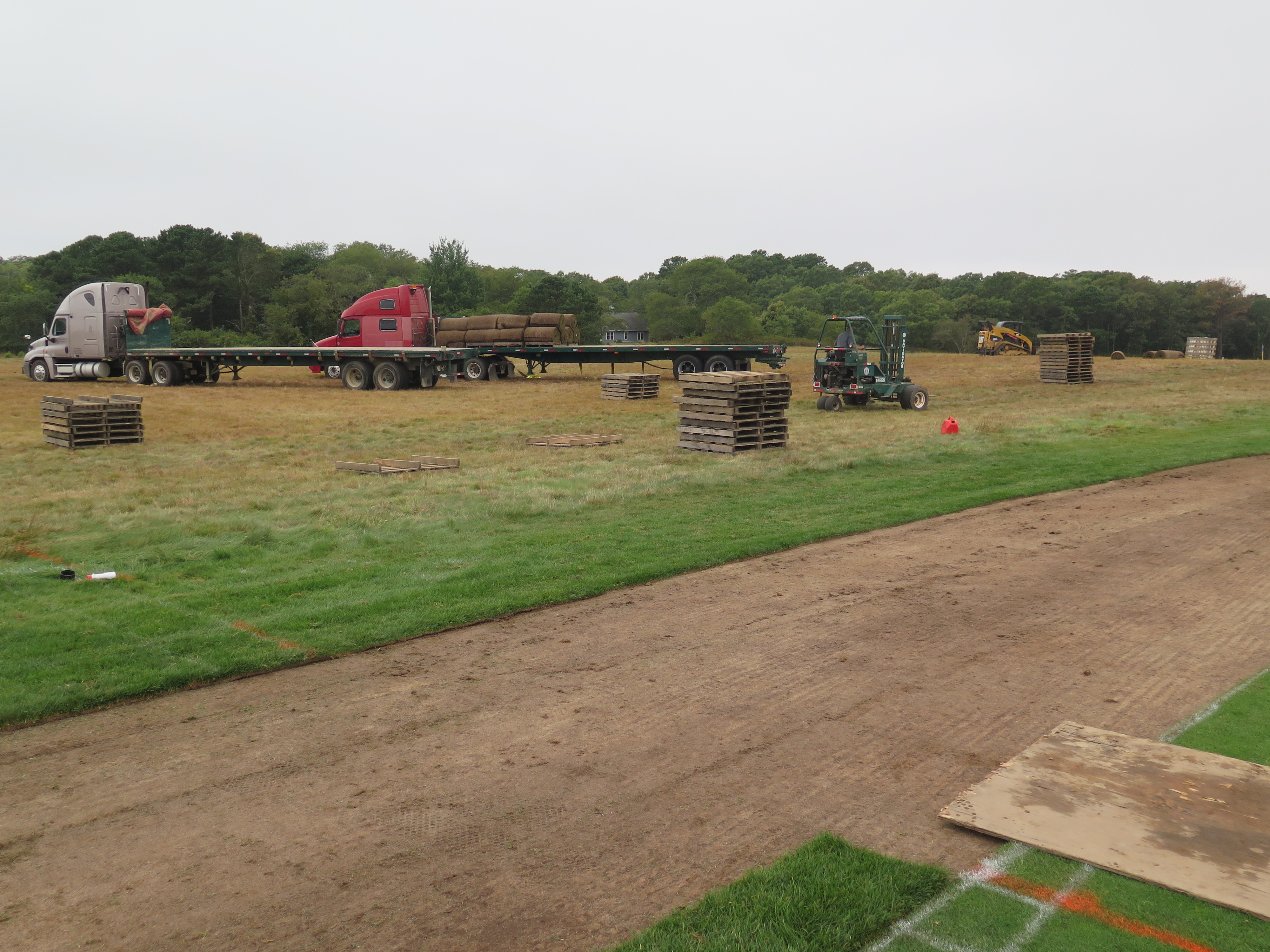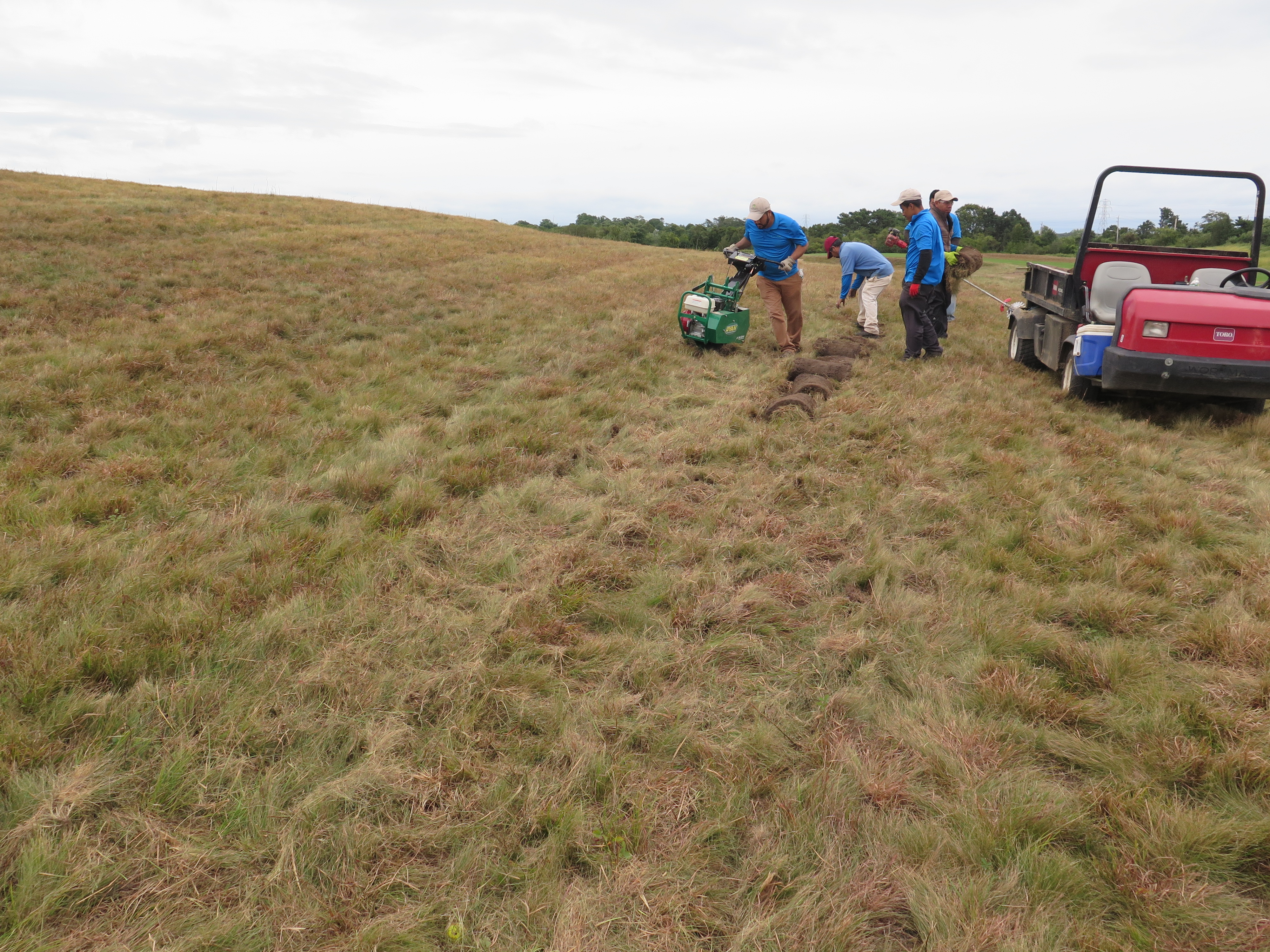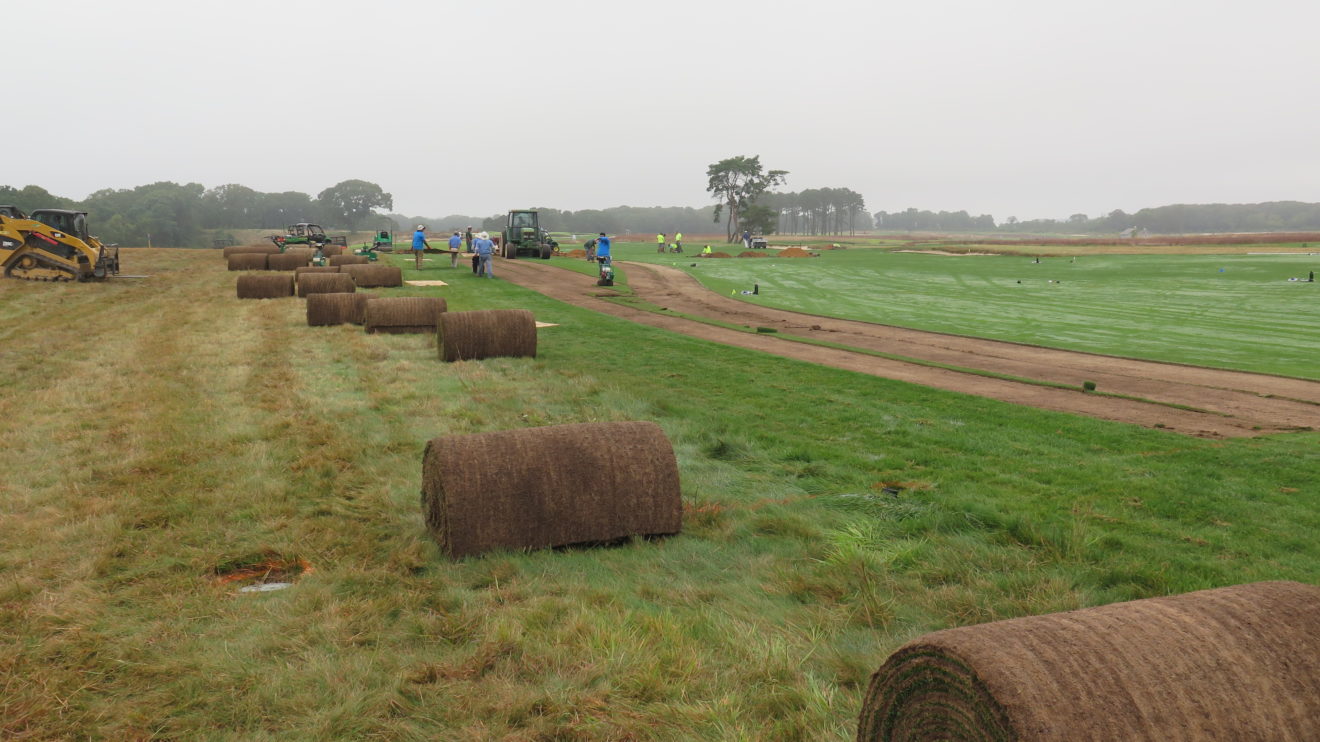SOUTHAMPTON, NY – It’s the best golf design magic trick since Oakmont made 5,000 trees disappear. Now you see it, now you don’t – prest-o! change-o! – and with a wave of a wand, a whiff of diesel and a crackerjack grounds crew, the fairways of 2018 U.S. Open host Shinnecock Hills narrowed pretty much overnight.
Penn and Teller got nothin’ on Shinnecock head super Jon Jennings and the USGA.
Remember back in 1979 when the Open was held at Inverness and an affable pro named Lon Hinkle got a 26-foot tall Black Hill Spruce named after him? The Infamous Hinkle Tree that…appeared…overnight between rounds one and two? The New York Times’ Dave Anderson quipped that only God and the USGA can make a tree.
Well they’re at it again with what some purists call voodoo architecture, but most others praise as both necessary and clever. Long strips of fairway sod on several par 4s and par 5s were cut up like long ribbons, rolled up, and then shipped for storage to a New Jersey facility called DeLea Sod. Shinnecock members in the right place at the right time actually saw the trucks cross over the George Washington Bridge. Roughly 132,000 square feet of fairway-height turf will be cared for by DeLea for a period of about 12 months.
Then USGA had the Shinnecock grounds crew, led by Jennings, roll out long stretches of rough-length fescue that was grown either at their own sod farm in New Jersey or that they got from the Shinnecock Hills Short Course. Voila! Instant fairway narrowing.
Cue Steppenwolf singing “Magic Carpet Ride.”
“Under normal circumstances, it takes close to two years to grow in rough when narrowing fairways for a U.S. Open at Shinnecock Hills,” explains a member who wishes to only be known in the press as Charles MacRaynor. He and another member code-named Rodney Zilla – who have been members of both Shinnecock Hills and National Golf Links of America for six decades – have had first-hand views of the work being performed by Jennings and the USGA.

“But starting last fall, they started tearing up one side of the fairway, rolling it up for storage, and then astro-turfing the place with this McRough they grew themselves or that they got from the Short Course. I’ve heard of imported olive oil and imported beer…but imported rough?” MacRaynor exclaimed puckishly.
He has a point, sort of. Purists can and will yell that the USGA is signing the Mona Lisa with a spray can and calling it art. Here’s iconic, venerable Shinnecock – a quintessential American course from the mists of golf history – painstakingly restored (and widened significantly) by the design tandem of Bill Coore and Ben Crenshaw.
Golf design aficionados sing whole arias about how entranced they are by the transformation; Shinny (as she’s sometimes called by her friends) looks and plays like it did when designer William Flynn completed it in 1931.
And then the USGA comes in and just rips up seven acres of fairways and lays down a big ol’ spinach patch.
But the USGA has a point too, and you have to also give them a bonus for creativity. It’s an unusual, but ingenious solution to a pesky problem: How do you toughen up a Golden Age golf course without erasing its strategic character? In particular, what do you do about Shinnecock? Shinnecock is relatively short for a major championship venue. According to the USGA’s Jeff Hall, USGA Managing Director for Rules and Open Championships, they added 450 yards since the last Open in 2004, but it still maxes out at 7,445 yards.
Moreover, with no wind, Shinnecock has surrendered low scores. Ray Floyd closed with a 66 to win in 1986, and that was with V-grooves and persimmon. With modern equipment, 50-60 yards wide fairways at Erin Hills and no wind last year, Brooks Koepka bludgeoned the place like Mighty Thor to the U.S. Open record-tying tune of 16-under (on a par-72 scorecard).
No one wants to see that happen to Shinnecock.

So here’s what they did: They removed fairway height turf at sections delineated by the USGA and replaced it with transplanted fescue. Some irrigation systems were impacted, so some sprinklers were moved. In some cases, they were replaced altogether by smaller sprinklers that won’t spray water as far (to prevent wet areas). They even had to have a wire tracker run over the turf to detect the pipes and wires accurately and safely. A specialist named Paul Roche from Golf Water designed the modified system and positioned the sprinklers.
Beginning with hole Nos. 1, 9 and 18, sprinkler heads were transitioned to the new location within the transitioned fairway lines, while mowed rough adjacent to the former fairway line was transplanted inward to the new fairway line. Any gaps between mowed rough and native rough were filled with native fescue transplanted from the Short Course. The transplanted native rough is cut thicker than traditional sod with more soil attached for facilitating faster establishment. (Yet its blade is designed to be thin and wispy.) Happily, the sod grew roots immediately into underlying soil.
As the project progressed, the third, sixth, 12th, 13th, 14th, 15th and 16th fairways were narrowed, while the surrounds of the eighth green also received new rough. The approach to the 16th fairway alone needed 13,000 square feet of new turf. Best of all, the playing angles will remain the sane, so the character and strategies of the hole stay exactly as they were before the USGA got there – the fairways are just skinnier without being the wasp-waisted bowling lanes that the players faced in U.S. Opens of a generation ago. And even so, according to Jeff Hall, this will be the widest U.S. Open in the modern era, with some fairway widths well into the 40-yard range or even exceeding 50 yards.
Don’t underestimate how gargantuan a project this was – especially to get done in the span of less than 10 days and nights...yes, nights. Some evenings, Jennings and company lit up Shinnecock so brightly, you’d have thought English rockers Oasis were hosting either a concert or a soccer game. (They do both from time to time, and they make as much noise at each, apparently.) Plus the USGA avoided rolling the dice on yet another bad spring season, as happens so often in the northeast. Everything was completed long before winter started to bite.
Most importantly, it plays well. Reports from both members and from GNN owner Ryan Ballengee are that the turf is healthy and uniform. It will prove a stiff challenge.
“I had to hit it out with a wedge,” said one player, a two handicap. “And even then sometimes it went sideways. These guys will have their hands full. I don’t think under par will win.”
This is the state of the art of the craft of golf course management and maintenance in the 21st century, and the end result looks perfectly natural. If somebody hadn’t have squealed, we might never have noticed.

Fairway narrowing at Shinnecock is absolutely necessary for a U.S. Open. In the Mike Davis era of “graduated rough” – where, ideally, the Cost of Rough Index increases incrementally the further offline you go – driving accuracy, which needs to remain an important part of the examination, has diminished significantly. Just look at where past champions finished in the Fairways Hit statistic:
From 1997-2005, the winners ranked, in order: T-13, T-3, T-8, T-14, T-15, T-7, 2nd, T-12 and T-8. That’s an average of ninth pre-Mike Davis.
However from 2006 forward the winners ranked, in order, T-21, T-48, T-56 (Tiger at Torrey), T-13, T-34, T-26, T-13, T-2, T-9, T-68, T-18 and T-4. That’s an average of 26th.
So pre-Mike Davis, champions finished inside the top 10 in driving accuracy. Now guys win Opens T-20s and even higher. Heck, Angel Cabrera won in 2007 with a final round stat of five fairways hit…at Oakmont. That’s the stat of a guy who shoots 79, not the 69 he carded to win.
The other critical change is arguably even more controversial but equally necessary. The USGA had to do something about the par-3 seventh. Golf design aficionados remember seven as one of the great Redan holes in golf.
The rest of the golf world, however, recalls it as the site of a mortifying, monumental gaffe that burned like a proprietary torch over the 2004 U.S. Open. The golf course, its greens, as former USGA official Frank Hannigan once put it, already starved and on life support was beginning to get away from the USGA, and No. 7 was ground zero for the kerfuffle. Though only 189 yards in length, it’s fiendishly contoured green with roll-offs into surrounding bunkers is difficult enough to hit and putt on under optimum conditions.
But forewarned on Saturday night that the USGA especially needed to water No. 7 and not to cut or roll that green, rolling and cutting happened while watering didn’t. So the first two groups through on Sunday became a comedy act, playing hockey back and forth across the green and putting into bunkers and into swales.
To quote David St. Hubbins of Spinal Tap after the Stonehenge debacle, “It was not fun to be part of the comedy on stage. Backstage perhaps it was very amusing.”
Kevin Stadler had a similar sentiment. He was one of the four guys that looked like your old Aunt Sally playing golf and not a PGA professional.
“I had two feet for par and ended up with a six,” he groused sourly, and with good reason. “Then they watered the green after we went through. I don’t know what the hell’s going on.

To be exact, they watered the green after every subsequent group went through. The sight of giant nozzles appearing and hosing down the green on international television was completely surreal. Some pros claimed the watering didn’t even do any good.
“I don’t even think the water began to seep into the ground. It just sort of beads up and rolls off like a waxed car,” said Mark Calcavecchia.
It was embarrassing, as Walter Driver and Hannigan, both well-liked, well-respected former USGA officials candidly admitted at various times. But this year, the USGA is determined to beat that monkey off their backs with a gap wedge.
“We learned from that,” Hall declared firmly. “First, we learned to communicate better with the host club. We have daily meetings with the super, Jon Jennings, so that we and the club are always on the same page.”
That’s a great idea, because Jennings is a masterful Head Superintendent. A superb all-around athlete who can still run speedy half-marathons and ski the country’s toughest double black diamond ski runs, Jennings’s devotion to and experience with great Golden Age architecture is a huge benefit to both Shinny and the USGA. Better still, he already has significant USGA tournament experience; he was head super at fabled Chicago Golf Club when the 2005 Walker Cup was contested. He also has PGA Tour experience as the head super at En-Joie Golf Course in Binghamton, former site of the B.C. Open.
“He was terrific at the ’05 Walker Cup, tremendously detail oriented,” Hall complimented, visibly grateful.
Together, all sides crafted a reasonable solution. This year, at both Nos. 7 and 11, the most severely contoured par 3s, the surrounding chipping swales and run off areas are wider, and a swath of slightly higher fairway cut has been introduced around greenside bunkers to limit the likelihood of putts rolling into them. As Hall said in interview for an earlier article for Golf Course Trades Magazine, “We don’t want to see balls funneling off the green into the front bunkers, so we put in a buffer of fescue rough….if a ball has some pace on it – if it’s a bad shot – it will still go in that bunker, and that’s the way it should be. A bad shot should go into the bunker, but a good one should not.”
That’s fair. We want difficult but not clownish. Many members and most golf design cognoscenti – like MacRaynor and Zilla - believe No. 7 is designed to be exceptionally difficult, even with a short iron in your hands. (In 2004 only 33 percent of the field hit the green for the entire week, but that was after Sunday saw a paltry 17 percent hit it in regulation.) That’s fine, too – par 3s are not just breather holes or pushovers.
“Seven has a character and identity all it’s own. It’s a perilous par-3,” said MacRaynor. “You should be worried about putting off that green if you're not careful. I hope that ethos is protected.”
That’s fine, but no one wants the Scooby-Doo villain silliness of ’04 either. The USGA, and in particular former tournament director Tom Meeks, have had to live with that ignominy for 14 years. A lot of water has gone under a lot of bridges in order to get Shinnecock back in the informal U.S. Open rotation where it belongs, ancient stronghold of American golf that it is. There’s a palpable feeling of inspiration for this Open to come off without a hitch, and “Do it for Meeksy” could be a good unspoken rallying cry, and redemption is always a story we all can root for. Success at this year’s U.S. Open means that Meeks won’t have to feel like Buckner walking back into Shea every time he hears the word “Shinnecock.” And you don’t get to be tournament director of the U.S. Open without making some significant contributions to the game of golf over the course of your career.
And so it’s with a magical flourish and a Harry Potter-esque incantation that we get a Shinnecock specially tailored to challenge the game’s greatest, while preserving the angles and strategies of the original design. As they say in show biz, “Don’t try this at home,” because it will cost your club too many grillions of dollars. But from an agronomic standpoint it’s good to know we can do it, and that we pulled it off in the biggest way imaginable.
Kind of like what the players are going to have to do - which is what William Flynn intended all along back in 1931 when he designed the course.

